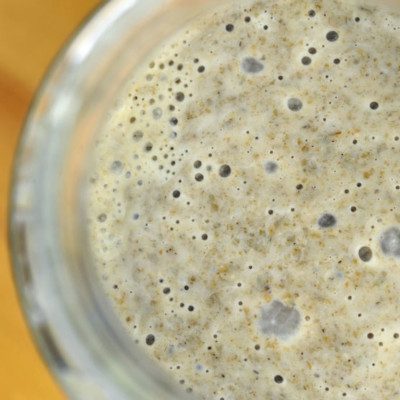Origin
Masa Madre has been used as an essential ingredient in the production of wheat and rye bread for several hundred years in Spain and Latin American countries. This type of preferment is essentially a piece of dough from the previous batch that’s kept until the next batch. When mixed with flour, salt, and water, the starter forms bread dough.2,3
In many households, Masa Madre is seen as a source of pride. Small portions of starter are typically passed on from generation to generation of bakers to perpetuate the flavor, aroma and texture of artisan bread.
How Masa Madre is made
* Optional ingredients: wheat bran, rye flour, rolled oats, malt flour, honey
Critical parameters to control during Masa Madre fermentation
- pH of preferment: should be medium between 4.2 and 3.5
- % hydration: similar to sourdough preferment, the flour/water mixture for Masa Madre can be liquid or have the consistency of a dough depending on the water absorption.
- Total titratable acidity (TTA): usually higher than 6 mL of 0.1 M NaOH
- Content of lactic and acetic acids
- Microbial parameters: number and species of LAB and yeast
- pH of finished product: Masa Madre bread usually has a pH lower than 4.8
Lactic acid bacteria (LAB) are mainly responsible for the acidification of Masa Madre (i.e. through production of lactic/acetic acid), whereas the yeasts are very important for the production of CO2, ethanol and flavor compounds. The levels of LAB in sourdoughs are 108–109 CFU/g and yeasts are 106–107 CFU/g, respectively. The LAB:yeast ratio in Masa Madre ferments is generally 100:1.
Feeding Masa Madre
Feeding of the Masa Madre culture can be done by using flour and water exclusively. The Masa Madre ferment must be properly fed for the following reasons:
- Aerate the medium: provide oxygen for optimum biomass growth
- Provide more food, like starch and simple sugars, for the microorganisms present in the medium
- Re-balance the acidity of medium through water bath
Application
How to use Masa Madre in bread production:

Masa Madre ferment is mostly incorporated into the final bread dough at levels higher than 5%. In artisan bread, this may go as high as 20 to 50% as the normal range.
As a general rule, the higher the level of Masa Madre incorporation in bread, then the:3,4
- Stronger the flavor and the superior the aroma
- Higher the nutritional value
- Higher the protection against rope contamination
- Lower the glycemic index
- Higher bioavailability of minerals
- Longer mold-free period and the longer the textural shelf-life
Masa Madre can be dehydrated and sold as such only if its microflora remains alive and viable to fully perform its functionality in the dough and finished product. Commercial presentations of Masa Madre in powder form are available to high-speed bakers but its adoption has been rather slow.
References
- Ministerio de la Presidencia, Relaciones con las Cortes e Igualdad. Real Decreto 308/2019 de 26 de abril, por el que se aprueba norma de calidad para el pan. Núm. 113 Sábado 11 de mayo de 2019 Sec. I. Pág. 50168.
- Cappelle, S., et al. “History and Social Aspects of Sourdough.” Handbook on Sourdough Biotechnology, Springer Science+Business Media New York, 2013, pp. 1–3.
- Hansen, A.S. “Sourdough Bread.” Handbook of Food and Beverage Fermentation Technology, Marcel Dekker, Inc., 2004, pp. 746–772.
- Hutkins, R.W. “Bread.” Microbiology and Technology of Fermented Foods, 2nd Edition, IFT Press and Wiley Blackwell, John Wiley & Sons, Inc, 2019, pp. 301–342.


